Theoretical description
In optics, two non-Lambertian sources that emit beamed energy can interact in a way that causes a shift in the spectral lines. It is analogous to a pair of tuning forks with similar frequencies (pitches), connected together mechanically with a sounding board; there is a strong coupling that results in the resonant frequencies getting "dragged down" in pitch. The Wolf Effect requires that the waves from the sources are partially coherent - the wavefronts being partially in phase. Laser light is coherent while candlelight is incoherent, each photon having random phase. It can produce either redshifts or blueshifts, depending on the observer's point of view, but is redshifted when the observer is head-on. [3]
For two sources interacting while separated by a vacuum, the Wolf effect cannot produce shifts greater than the linewidth of the source spectral line, since it is a position-dependent change in the distribution of the source spectrum, not a method by which new frequencies may be generated. However, when interacting with a medium, in combination with effects such as Brillouin scattering it may produce distorted shifts greater than the linewidth of the source.
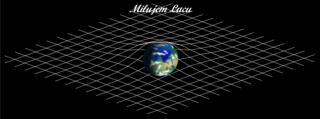
In physics and general relativity, gravitational redshift is the phenomenon that electromagnetic waves or photons travelling out of a gravitational well lose energy. This loss of energy corresponds to a decrease in the wave frequency and increase in the wavelength, known more generally as a redshift. The opposite effect, in which photons gain energy when travelling into a gravitational well, is known as a gravitational blueshift. The effect was first described by Einstein in 1907, eight years before his publication of the full theory of relativity.

In physics, a redshift is an increase in the wavelength, and corresponding decrease in the frequency and photon energy, of electromagnetic radiation. The opposite change, a decrease in wavelength and simultaneous increase in frequency and energy, is known as a negative redshift, or blueshift. The terms derive from the colours red and blue which form the extremes of the visible light spectrum.

The visible spectrum is the portion of the electromagnetic spectrum that is visible to the human eye. Electromagnetic radiation in this range of wavelengths is called visible light or simply light. A typical human eye will respond to wavelengths from about 380 to about 750 nanometers. In terms of frequency, this corresponds to a band in the vicinity of 400–790 terahertz. These boundaries are not sharply defined and may vary per individual. Under optimal conditions these limits of human perception can extend to 310 nm (ultraviolet) and 1100 nm. The optical spectrum is sometimes considered to be the same as the visible spectrum, but some authors define the term more broadly, to include the ultraviolet and infrared parts of the electromagnetic spectrum as well.
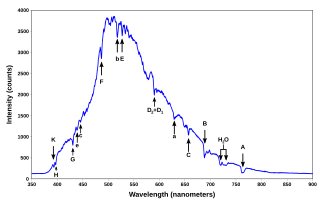
A spectral line is a weaker or stronger region in an otherwise uniform and continuous spectrum, resulting from emission or absorption of light in a narrow frequency range, compared with the nearby frequencies. Spectral lines are often used to identify atoms and molecules. These "fingerprints" can be compared to the previously collected ones of atoms and molecules, and are thus used to identify the atomic and molecular components of stars and planets, which would otherwise be impossible.
In physics, two wave sources are coherent if their frequency and waveform are identical. Coherence is an ideal property of waves that enables stationary interference. It contains several distinct concepts, which are limiting cases that never quite occur in reality but allow an understanding of the physics of waves, and has become a very important concept in quantum physics. More generally, coherence describes all properties of the correlation between physical quantities of a single wave, or between several waves or wave packets.

A dye laser is a laser that uses an organic dye as the lasing medium, usually as a liquid solution. Compared to gases and most solid state lasing media, a dye can usually be used for a much wider range of wavelengths, often spanning 50 to 100 nanometers or more. The wide bandwidth makes them particularly suitable for tunable lasers and pulsed lasers. The dye rhodamine 6G, for example, can be tuned from 635 nm (orangish-red) to 560 nm (greenish-yellow), and produce pulses as short as 16 femtoseconds. Moreover, the dye can be replaced by another type in order to generate an even broader range of wavelengths with the same laser, from the near-infrared to the near-ultraviolet, although this usually requires replacing other optical components in the laser as well, such as dielectric mirrors or pump lasers.
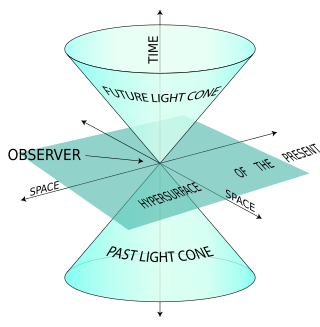
The relativistic Doppler effect is the change in frequency of light, caused by the relative motion of the source and the observer, when taking into account effects described by the special theory of relativity.
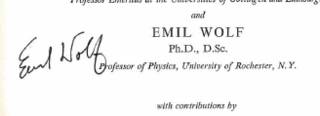
Emil Wolf was a Czech-born American physicist who made advancements in physical optics, including diffraction, coherence properties of optical fields, spectroscopy of partially coherent radiation, and the theory of direct scattering and inverse scattering. He was also the author of numerous other contributions to optics.
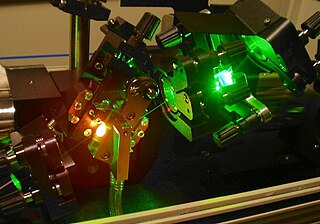
Ti:sapphire lasers (also known as Ti:Al2O3 lasers, titanium-sapphire lasers, or Ti:sapphs) are tunable lasers which emit red and near-infrared light in the range from 650 to 1100 nanometers. These lasers are mainly used in scientific research because of their tunability and their ability to generate ultrashort pulses. Lasers based on Ti:sapphire were first constructed and invented in June 1982 by Peter Moulton at the MIT Lincoln Laboratory.
Tired light is a class of hypothetical redshift mechanisms that was proposed as an alternative explanation for the redshift-distance relationship. These models have been proposed as alternatives to the models that require metric expansion of space of which the Big Bang and the Steady State cosmologies are the most famous examples. The concept was first proposed in 1929 by Fritz Zwicky, who suggested that if photons lost energy over time through collisions with other particles in a regular way, the more distant objects would appear redder than more nearby ones. Zwicky himself acknowledged that any sort of scattering of light would blur the images of distant objects more than what is seen. Additionally, the surface brightness of galaxies evolving with time, time dilation of cosmological sources, and a thermal spectrum of the cosmic microwave background have been observed—these effects should not be present if the cosmological redshift was due to any tired light scattering mechanism. In 2006 an alternative model named "New Tired Light" was proposed by Lyndon Ashmore. In this model the energy loss of photons over distance is due to recoil of electrons as they interact with photons, absorb and re-emit primary and secondary radiation, leading to red-shifting. As the primary radiation upon re-emission is in the line of sight, no blurring would ensue. Additionally in a paper was published which reported that for the first time the dispersion measure of a fast radio burst and the redshift of a host galaxy had been found, these results were within 1.2% margin of error predicted by New Tired Light ten years prior.
Four-wave mixing (FWM) is an intermodulation phenomenon in nonlinear optics, whereby interactions between two or three wavelengths produce two or one new wavelengths. It is similar to the third-order intercept point in electrical systems. Four-wave mixing can be compared to the intermodulation distortion in standard electrical systems. It is a parametric nonlinear process, in that the energy of the incoming photons is conserved. FWM is a phase-sensitive process, in that the efficiency of the process is strongly affected by phase matching conditions.

The Pound–Rebka experiment monitored frequency shifts in gamma rays as they rose and fell in the gravitational field of the Earth. The experiment tested Einstein's 1907 and 1911 predictions, based on the equivalence principle, that photons would gain energy when descending a gravitational potential, and would lose energy when rising through a gravitational potential. It was proposed by Robert Pound and his graduate student Glen A. Rebka Jr. in 1959, and was the last of the classical tests of general relativity to be verified. The measurement of gravitational redshift and blueshift by this experiment validated the prediction of the equivalence principle that clocks should be measured as running at different rates in different places of a gravitational field. It is considered to be the experiment that ushered in an era of precision tests of general relativity.
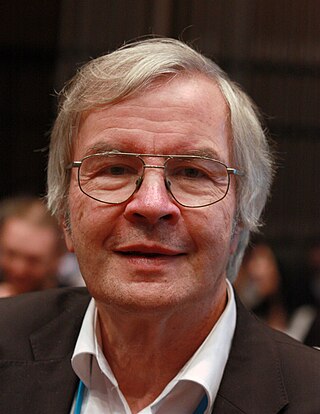
Theodor Wolfgang Hänsch is a German physicist. He received one-third of the 2005 Nobel Prize in Physics for "contributions to the development of laser-based precision spectroscopy, including the optical frequency comb technique", sharing the prize with John L. Hall and Roy J. Glauber.

The Rossiter–McLaughlin effect is a spectroscopic phenomenon observed when an object moves across the face of a star.
In spectroscopy, the Autler–Townes effect, is a dynamical Stark effect corresponding to the case when an oscillating electric field is tuned in resonance to the transition frequency of a given spectral line, and resulting in a change of the shape of the absorption/emission spectra of that spectral line. The AC Stark effect was discovered in 1955 by American physicists Stanley Autler and Charles Townes.

In optics, a supercontinuum is formed when a collection of nonlinear processes act together upon a pump beam in order to cause severe spectral broadening of the original pump beam, for example using a microstructured optical fiber. The result is a smooth spectral continuum. There is no consensus on how much broadening constitutes a supercontinuum; however researchers have published work claiming as little as 60 nm of broadening as a supercontinuum. There is also no agreement on the spectral flatness required to define the bandwidth of the source, with authors using anything from 5 dB to 40 dB or more. In addition the term supercontinuum itself did not gain widespread acceptance until this century, with many authors using alternative phrases to describe their continua during the 1970s, 1980s and 1990s.
Electromagnetically induced grating (EIG) is an optical interference phenomenon where an interference pattern is used to build a dynamic spatial diffraction grating in matter. EIGs are dynamically created by light interference on optically resonant materials and rely on population inversion and/or optical coherence properties of the material. They were first demonstrated with population gratings on atoms. EIGs can be used for purposes of atomic/molecular velocimetry, to probe the material optical properties such as coherence and population life-times, and switching and routing of light. Related but different effects are thermally induced gratings and photolithography gratings.

Francisco Javier "Frank" Duarte is a laser physicist and author/editor of several books on tunable lasers.
The N-slit interferometer is an extension of the double-slit interferometer also known as Young's double-slit interferometer. One of the first known uses of N-slit arrays in optics was illustrated by Newton. In the first part of the twentieth century, Michelson described various cases of N-slit diffraction.
Fritz Peter Schäfer was a German physicist, born in Hersfeld, Hesse-Nassau. He is the co-inventor of the organic dye laser. His book, Dye Lasers, is considered a classic in the field of tunable lasers. In this book the chapter written by Schäfer gives an ample and insightful exposition on organic laser dye molecules in addition to a description on the physics of telescopic, and multiple-prism, tunable narrow-linewidth laser oscillators.












